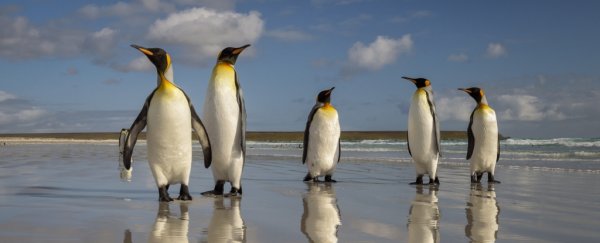The world's largest king penguin colony has dramatically collapsed, and as yet scientists just don't know why. From 2 million members in the 1980s, including 500,000 breeding pairs, the population on the sub-Antarctic Île aux Cochons has shrunk to just 60,000 breeding pairs.
Using recent high-resolution satellite data from 2005 onwards, and helicopter and satellite images taken in 1982 and 1988, researchers from the Chizé Centre for Biological Studies (CNRS) have measured the changes in the colony since a crew of scientists last visited the island in 1982.
The colony, which has been known about since the 1960s, has lost 88 percent of its population, the researchers found. This constitutes an entire third of all the king penguins in the world.
 The breeding ground size in 1982, 2005 and 2015. (Henry Weimerskirch)
The breeding ground size in 1982, 2005 and 2015. (Henry Weimerskirch)
To estimate the current colony sizes, the research team studied the contours of the island, and calculated how much of it is covered by vegetation. This is because breeding king penguin colonies occupy flat, or gently sloping, unvegetated ground, at a rate of 1.6 to 2.2 penguins per square metre.
Since the 1980s, the vegetation has encroached greatly on these breeding grounds, indicating a corresponding population collapse.
But it's extremely puzzling - because nearby colony populations on other islands haven't experienced similar declines. A colony on Île de la Possession has remained more or less stable since the 1960s, while colonies on Marion Island and the Kerguelen Islands have increased.
This leads researchers to believe that the reason for the decline is specific to Île aux Cochons, rather than global - which would seem to rule out climate breakdown as a complete explanation for the decline.
But that doesn't mean that there is no explanation - just that scientists haven't figured out what it is yet. And the research team put forth several possibilities in their paper.
The Indian Ocean Dipole event in 1997, for instance, in which the surface temperatures in the Indian Ocean oscillate, affected the foraging capabilities of king penguins on Île de la Possession, which in turn had a negative impact on their breeding performance.
That colony has since recovered, but it's possible this event had a greater impact on the Île aux Cochons colony, and it is taking longer to recover.
Another explanation is relocation. King penguins tend to stay faithful to their birthplace and first breeding ground, but 2005 satellite images showed a separate colony closer to the beach that had not been seen before. However, the size of this colony was too small to account for the entire loss.
Introduced species, such as feral cats and house mice, are known on the island, which could have had a negative impact on the population; or a tick or disease infestation is also possible.
A disease that affected such a large swathe of the population would be unprecedented, the researchers said, but ticks have been known to wipe out large numbers of king penguins - Marion Island had a tick problem in the early 90s, although, again, it didn't affect as large a percentage of the population - and, again, that colony has recovered.
A natural disaster is unlikely, though. There has been no evidence of volcanic activity, and a tsunami would not reach as far inland as the colony's grounds.
The last time scientists set foot on the island was in 1982, and satellite imagery can only provide so much information. The best course of action, the researchers argue, is to send an expedition to see conditions first-hand and search for signs of anything that may adversely affect the colony.
"The cause of the massive decline of the colony remains a mystery, and needs to be resolved," they wrote in their paper.
"Although the decline started at least 20 years ago, it appears to be ongoing, and the causes of the decline may still be active."
The research has been published in the journal Antarctic Science.
